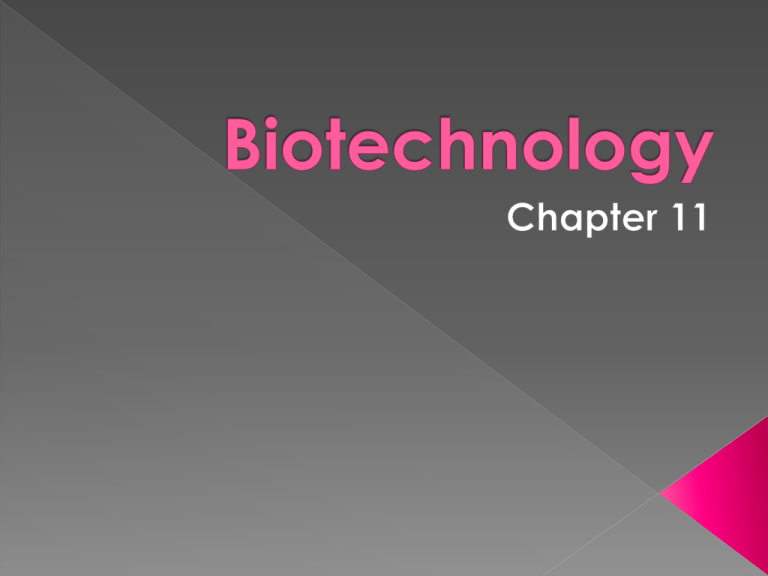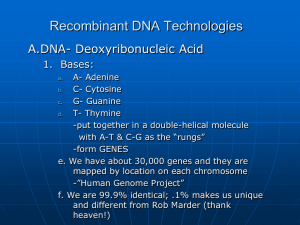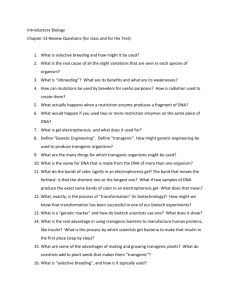Biotechnology
advertisement

Process of manipulating genes for practical purposes. Process in which biologists make changes in the DNA code of a living organism. A technology in which the genome of a living cell is modified for medical or industrial use. Genetic engineering can involve building recombinant DNA. DNA molecules that are artificially made from two or more different organisms. Steps in a genetic engineering experiment Please look over the 4 steps in a genetic engineering experiment on page 229. DNA from the organism containing the gene of interest is cut by are enzymes that destroys foreign DNA molecules by cutting them at specific sites. are bacterial enzymes that recognize and bind to specific short sequences of DNA, and then cut the DNA between specific nucleotides within the sequence. The DNA from a vector is also cut. Vector – is an agent that is used to carry the gene of interest into another cell. › Commonly used vectors include: Viruses Yeast Plasmids – from bacterial cells Plasmid are circular DNA molecules that can replicate independently of the main chromosomes of bacteria The DNA fragments from the organism containing the gene of interest are combined with the DNA fragments from the vector. The host cells then take up the recombinant DNA. Gene Cloning – many copies of the gene of interest are made each time the host cell reproduces Remember that bacteria reproduce asexually by binary fission so it produces identically offspring. Cells that received the particular gene of interest are distinguished, or separated, from the cells that did not take up the gene of interest. The cells can transcribe and translate the gene of interest to make the protein coded for in the gene. Gel electrophoresis RFLP PCR Analysis – Polymerase Chain Reaction Technique that uses an electric field within a gel to separate DNA molecules by their size. DNA fragments are placed at one end of a porous gel and an electric voltage is applied to the gel. Restriction enzymes cut DNA into fragments The DNA fragments are poured into wells on a gel. The electric voltage is applied to the gel. The smaller the DNA fragment, the faster and farther it will move across the gel. The polymerase chain reaction (PCR) is a scientific technique in molecular biology to amplify a single or a few copies of a piece of DNA across several orders of magnitude, generating thousands to millions of copies of a DNA . A method of making many copies of a piece of DNA Restriction fragment length polymorphism or RFLP analysis is used to identify a change in the genetic sequence that occurs at a site where a restriction enzyme cuts. RFLPs can be used to trace inheritance patterns, identify specific mutations, and for other molecular genetic techniques. Forensics Gene therapy: the insertion, alteration, or removal of genes within an individual's cells and biological tissues to treat disease. Vaccines Through the recombinant-DNA procedure, it is now possible to transfer the genes that stimulate antibody formation to a harmless microorganism and use it as a vaccine against the particular disease. Vaccines have been successfully created using the harmless cowpox virus, the herpes simplex type I virus (cold sores), the influenza virus, and the hepatitis B virus through gene splicing. Genetically Modified Crops Cloning A clone is a member of a population of genetically identical cells produced from a single cell. In 1997, Ian Wilmut cloned a sheep called Dolly. Transgenic Organisms An organism described as transgenic, contains genes from other species. Transgenic Microorganisms Transgenic bacteria produce important substances useful for health and industry. Transgenic bacteria have been used to produce: insulin growth hormone clotting factor Transgenic Plants Transgenic plants are now an important part of our food supply. Many of these plants contain a gene that produces a natural insecticide, so plants don’t have to be sprayed with pesticides. Transgenic Animals Transgenic animals have been used to study genes and to improve the food supply. Mice have been produced with human genes that make their immune systems act similarly to those of humans. This allows scientists to study the effects of diseases on the human immune system. Researchers are trying to produce transgenic chickens that will be resistant to the bacterial infections that can cause food poisoning.





